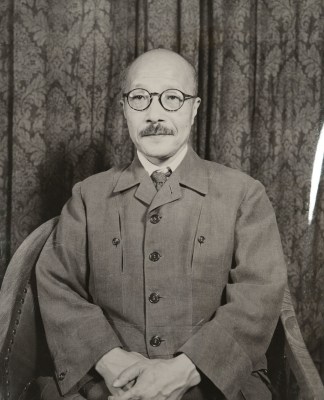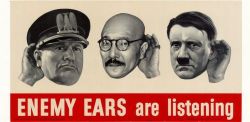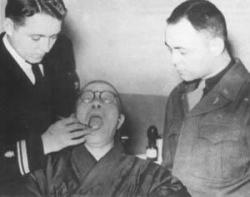The Baader-Meinhof effect is the common name for what scientists call frequency illusion. Suppose you are watching Star Trek’s Christopher Pike explain how he makes pasta mama, and you’ve never heard of it before. Immediately after that, you’ll hear about pasta mama repeatedly. You’ll see it on menus. Someone at work will talk about having it at Hugo’s. Here’s the thing. Pasta mama was there all along (and, by the way, delicious). You just started noticing it. We sometimes wonder if that’s the deal with Morse code. Once you know it, it seems to show up everywhere.

One of the strangest places we’ve ever heard of Morse code appearing is the infamous case of Tojo’s teeth. If you don’t remember, General Hideki Tojo was one of the main “bad guys” in the Pacific part of World War II. In particular, he is thought to have approved the attack on Pearl Harbor, which started the American involvement in the war globally. Turns out, Tojo would be inextricably tied to Morse code, but he probably didn’t realize it.
The Honorable Attempt
At the end of the war, the US military had a list of people they wanted to try, and Tojo was near the top of their list of 40 top-level officials. As prime minister of Japan, he had ordered the attack that brought the US into the war. He remained prime minister until 1944, when he resigned, but the US had painted him as the face of the Japanese enemy. Often shown in caricature along with Hitler and Mussolini, Tojo was the face of the Japanese war machine to most Americans.

When Americans tried to arrest him, though, he shot himself. However, his suicide attempt failed. Reportedly, he apologized to the American medics who resuscitated him for failing to kill himself. Held in Sugamo Prison awaiting a trial, he requested a dentist to make him a new set of dentures so he could speak clearly during the trial.
A Morse Code Dentist
Jack Mallory, a young Navy dentist on loan to the Army, drew the duty of making Tojo’s new dentures. The 22-year-old had been at the 361st Station Hospital for about a month. His roommate, George Foster, had examined Tojo and brought Jack in to make an upper denture. Tojo had declined a full set because he did not expect to survive his trial.

The standard procedure was to engrave the patient’s name, rank, and serial number of any dentures made by the hospital. However, Mallory’s colleague suggested that it would be fitting to engrave Tojo’s with the common phrase “REMEMBER PEARL HARBOR.” At 22, you are often susceptible to bad ideas, but Jack knew that could get him in trouble. But he decided to do it any way but to make it less conspicuous, he used — you guessed it — Morse code.
At first, only Jack and his roommate knew the secret. However, two recruits had to be let into the secret because they were examining the dentures and were sure to notice. One of them wrote home about the incident, and, as you might expect, the military command was not amused. Mallory’s commanding officer ordered him to remove the markings, which he did, and everyone denied it ever happened. As far as anyone knows, Tojo never knew that his dentures had carried a secret message.
General Tojo’s trial didn’t go well for him, and he was executed late in 1948. Jack had been back in the states for over a year, reuniting with his wife and starting a dental practice. The story would only surface again years later, in 1995.
Code is Everywhere
Of course, soldiers have a long history of using Morse code to communicate secretly, like Admiral Denton blinking “torture” during his appearance in a propaganda film made by his captors during the Vietnam war. The Colombian army encoded secret messages to captive soldiers in a pop song.
Even civilian songs get into the act. There are a ton of songs that have some Morse code embedded in them, ranging from London Calling by the Clash to YYZ by Rush and many others. The Capitol Records building sends out Morse code, although it seems most people don’t notice. Not many people realize that the beat of the theme music to Mission Impossible actually spells out MI, either.
Then there’s the Curiosity Mars rover. The wheels on that plucky vehicle leave the letters JPL in Morse code behind in the sand. However, our pet peeve these days is the “morse code bracelets” that use beads to spell out messages like “loved.” Why is that a pet peeve? Becuase there is no spacing between elements, so, for example, loved is “.-..—…-.-..” Of course, that could also be “aumski” or a bunch of other nonsense words.
As you can see, once you know Morse code, you can find it just about everywhere. You might even find it in your dreams. Too lazy to learn the code? Take the Blue Pill.















I’m just gonna drop a Repo Man reference here: “Plate o’ Shrimp”
That is one of my most favorite movie scenes ever! 👍👍👍
The 2nd “Hellbound” movie “Hellraiser” had a large geometric thing in the middle of the maze that slowly bleeped out G-O-D in morse code, using a foghorn.
And, of course, Barrington Pheloung’s themes for the “Inspector Morse” and “Endeavour” series featuring the name “Morse” in the eponymous code.
The C64 game Rambo First Blood Part II has morse code in the music, spelling out the names of the developers complete with typos.
Tojo was not a “bad guy,” he was a bad guy.
Morse Code was mentioned in Star Trek TNG and Voyager as well.
Oh you can “Take a Blue Pill” or grab a TRS 80 Model 100 to get your code…
https://youtu.be/A9-KeWW_s3o
If my failing “nvram” (?) memory serves me there was a program for the TRS 80 Model 1/3/4 that used the cassette port to do it also.
“Morse Code was mentioned in Star Trek TNG and Voyager as well. ”
Indeed. And they’re two of America’s better contributions to the world, too, if I may say so (I’m from EU). 👍
I’m speaking under correction, but I vaguely remember that Morse telegraphy was mentioned in 1960’s TOS, too.
In the Botany Bay episode, I suppose, in which the comm. officer receives an automated distress beacon message (CQD?) from aforementioned Botany Bay.
Anyway, I’m speaking under correction. Maybe it was in the localized version only and absent in English original.
“Be sure to drink your Ovaltine!”
-Little Orphan Annie
“You’ll shoot your eye out, kid.”
Wasn’t there an external hard drive that had Morse Code in its ventilation slots?
Western Digital
Then there’s the story about a high school production of “South Pacific”.
The Conductor of the orchestra asked the oboe player to play something that sounded like Morse Code during the part where the actors are receiving a radio signal. But, the oboe player was a young amateur radio “ham” that actually knew the Code.
Unknown to the Conductor, he played cuss words. The first 2 evening shows went without anyone knowing. The 3rd evening, someone in the audience broke out laughing.
Go ahead and rent a Uhaul to do a cross country move. Then notice the ridiculous amount of other Uhaul trucks and trailers on the road.
Although I do feel you run into more moving trailers on any corridor of the interstate that you’re likely to run your trailer on. Selection bias, if I’m getting my terminology right.
That’s more an allergic reaction that develops on exended exposure to them.
Source: Moved house halfway across the US in one . That “gentle ride” thing? No. Just no. Unsprung bucking bronco all the way. Bring a kidney belt.
Morse code is useful, because it uses the absolute minimum amount of power to transmit information without requiring any kind of specialised receiving equipment. And it’s surprisingly easy for the brain to pull out of background noise. All you need is a receiver with a BFO and a narrow filter. Even though it’s officially defunct in the maritime world, it’s still used to identify non directional beacons and VHF omnirange beacons in aviation. It’s good to know the basics, because Morse is probably the simplest way to communicat over long distances. Radio, flashlight, car horn…you might need it someday.
Communicating in prison, or buried under rubble.
” All you need is a receiver with a BFO and a narrow filter.”
Luxury!
Back in my day all we had was a shiny thing, sunlight, and a good eye to send and receive Morse Code!
Or a horn and a good ear.
Young whippersnappers mumble mumble
Morse is the only mode that can be sent using 4 different mediums.
Light, sound, radio and touch. It is also the only mode which can be understood by both blind and deaf people. And even people who are both blind and deaf.
>> It is also the only mode which can be understood by both blind and deaf people. And even people who are both blind and deaf.
Not the only. Braille, sign language and finger spelling can all be understood by those who are blind and/or deaf, to name a few.
Yes, but there are restrictions, too. The wire-based telegraphy used by American rail road (?) once knew a third character, between dit/dah. It was lost when wireless telegraphy took over.
Or so I heard. That’s why we ended up with HI (“I laugh”). Originally, it meant HO. Like Santa’s HO! HO! Makes sense, kind of.
The 3rd element in “American Morse” was an extended space within characters; this was done away with in International Morse to make it easier to learn. But there are still a few hams who use it among themselves in (Railroad Telegraphers Association, IIRC) on-the-air nets. If you see someone wearing a tiny Vibroplex key as a lapel pin, that person is an RTA member.
Correction/addition to my earlier reply re American Morse: that 3rd charachter may have heen an odd length element rather than a space. But I seem to recall that they played around with variable spacing inside letters too. Bear with me, I’m working off the top of my head with decades old memories here.
Thomas Edison went completely deaf. Because he had been a telegraph operator, earlier in his life, he was well-acquainted with Morse Code. Divorced, getting older and quite deaf, he taught Morse to the lady he was dating. When he proposed, he did so in Morse, tapping on the back of her hand. She replied, in Morse, that she’d have to get permission from her father. Her father was delighted that his “spinster” daughter was marrying someone as wealthy and famous as Edison.
Afterwards, they’d be sitting in some dinner party, tapping jokes, in Morse, on the back of the other one’s hand, and stifling laughter. Everyone else at the party was wondering what was going on, as they had no idea and, tapping on the back of someone’s hand, under the table, was completely covert.
The things you learn when you visit the Edison – Ford estates in Ft Myers, Florida.
” All you need is a receiver with a BFO and a narrow filter.”
Yes. But in the old days, not even that. A simple crystal radio was sufficient.
That’s an interesting detail only a few people remember. Early Morse telegraphy was NOT based on CW signals (Continus Wave) and thus audible in AM receivers.
Modern depictions of clean, sinusoidal 800 Hz Morse in times of the Titanic thus belong into the realms of phantasy, the sound was much more raw back then.
– See damped vs undamped waves for details. 🙂
Audio frequency AC alternators feeding spark gaps. Not exactly low bandwidth transmissions :-) but didn’t require a BFO.
Syntony and Spark is an excellent (though not inexpensive) guide to early RF. https://www.amazon.com/Syntony-Spark-Hugh-G-J-Aitken/dp/0691023921
They didn’t use spark to avoid BFOs, radio hadn’t progressed enough. Howard Armstrong was a hero.
Afaik, there were multiple concepts in early 20th century, before the tube/transistor.
The ones I know:
– Funkenstrecke (Engl. spark gap?)
– Knallfunkensender (Engl. spark-gap transmitter, too?)
– Löschenfunkensender (quenched-gap transmitter)
– Maschinensender (Engl. Alternator)
– Lichtbogensender (Engl. plasma arc?)
My apologies for using the German words here, but I’m not so familiar with the English ones. The dictionaries I use aren’t exactly precise, either. They have contradicting answers.
The Lichtbogensender (literally “light bow sender”) was almost tube-like. It could modulate audio, afaik.
To be fair, earlier, experimental spark transmitters could technically do it, too, by using multiple sparks or so I heard. But audio quality was horrible by comparison.
The Löschfunksender were still being used by maritime stations, such as ships on sea for a long time (up until the 1950s). Reason was their mechanical robustness and high-power output. Replacing tubes on sea wasn’t as easy as fixing a traditional transmitter.
Yes, the transmitters used various methods of generating electric arcs, and what the listener heard was a “hash” or buzzing noise being turned on and off. Later implementations used high frequency alternators, but that was short lived due to the introduction of tubes.
Yet somehow a fairly high percentage of the rest of the world wants to be us.
Source? I think most (wannabe) immigrants are from even poorer nations?
.-.. — .-..
Americans tend to overestimate the desirability of living in the US to a fair degree. In 2020 the destination of 61% of all global migrants was in either Europe or Asia (30% each). North America as a whole (US, Canada, and Mexico) was the destination for 21%. Many countries have immigrants (legal or illegal) as a larger percentage of the total population than does the US: Canada, Germany, Ireland, Switzerland, Austria, Sweden, Australia, and New Zealand to name just a few in the so-called “developed world”.
Last time I tried to learn Morse code I began to see it when I took the dog out for his business. Mostly ‘a’, ‘n’, and ‘e’ he does.
He’s trying to tell you something.
Dogs can see into the Spirit World, have you ever noticed them watching something but you don’t see what has their attention?
j/k
IIRC G. Gordon Liddy used to send -… … repeatedly during his radio show intro and conclusion.
Must have been for “shitty situation”. I have no other idea what any usage of ” ss ” as a phrase may connote
Put some Morse code into a commercial for a product once, text of which identified a particularly toxic business acquaintance, maybe a choice word describing said person. Turned out to a correct character judgement, he later went to federal prison for other unsurprising shenanigans..
It is hard to miss the Science Friday radio program theme music spelling out S C I F R I….
Western Digital made vent holes with a morse code message on the case of one of their external hard drives.
The british mystery series Inspector Morse which ran from the late 80’s into the 2000’s very clearly spells out MORSE in its theme music. There is some controversy as to whether sometimes the murderer is also named in code in the opening theme in some episodes. John Thaw whose character Morse is always doing the Times crossword puzzle. Of course with the name Morse and he being a puzzler it’s a natural to include hidden codes in the theme.
There’s also the QI theme, the Morse of the main melody reading “www.alan0andstephenhero.com” which redirects to a QI video playlist. The show ran for 12 years without this being noticed.